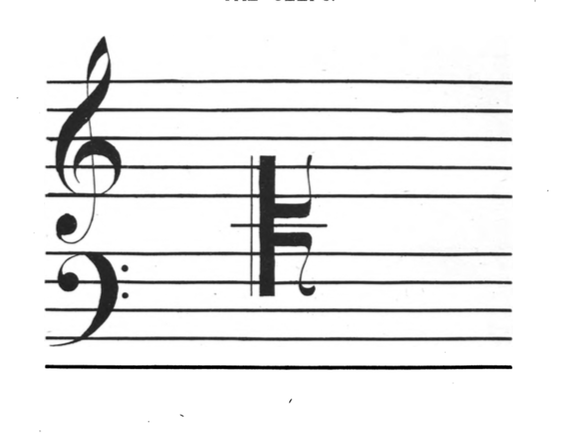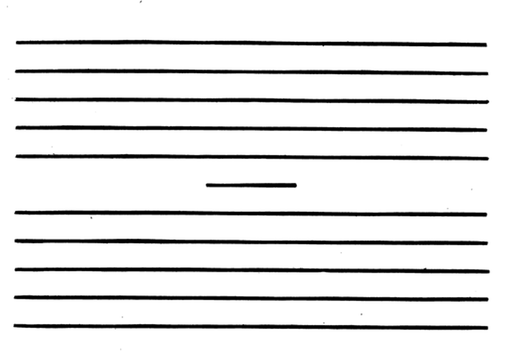The following lesson is preceded by:
Preliminary Lesson 1
Preliminary Lesson 2a
Preliminary Lesson 2b
Intervals
Preliminary Lesson 3
Preliminary Lesson 4a
Preliminary Lesson 4b
Preliminary Lesson 4c
Preliminary Lesson 4d
Preliminary Lesson 4e
Preliminary Lesson 5a
Aim of the Lesson To show the use of a five lined staff, and to lead up to the division of the eleven lined staff into two portions for piano music.
Preparation: Have a little discussion with the student about voices. Have you ever noticed the differences in pitch between peoples’ voices? What ideas does the student have about them? Father’s voice, mother’s voice, the child’s own voice, etc.
Method: Let’s draw a staff or look at a staff with all three clefs that we’ve learned.  This staff pictures ALL the lines that ALL the voices can sing. But no one voice could sing ALL the lines. Let’s try. Can we sing from low G all the way to high F? Impossible, right? Which of the sounds on the staff do you think the men would use to sing? Which of the sounds on the staff do you think the women would use to sing?
This staff pictures ALL the lines that ALL the voices can sing. But no one voice could sing ALL the lines. Let’s try. Can we sing from low G all the way to high F? Impossible, right? Which of the sounds on the staff do you think the men would use to sing? Which of the sounds on the staff do you think the women would use to sing?
Five lines are enough for one kind of voice. We can essentially take any five lines of the staff to make a little staff. If we want a group of lines that could be used for the sounds on the piano we consider middle pitch sounds, what lines could we use? We’d use the middle C line and the lines above and below. Maybe we could use the C clef and create a staff for the middle pitch sounds. Something like this:  Give a short exercise in naming and dictation with this C-staff. Ask the pupil to draw a staff for high voices and one for low voices. We understand now that the C clef is of no use here since it’s line isn’t needed in either group. This is an opportunity for the student to discover the need for the two other clefs. In piano music, we give each hand a difference voice to play. We divide the staff into two little ones. Middle C is left out and only used when needed. Here is the staff we use for playing the piano:
Give a short exercise in naming and dictation with this C-staff. Ask the pupil to draw a staff for high voices and one for low voices. We understand now that the C clef is of no use here since it’s line isn’t needed in either group. This is an opportunity for the student to discover the need for the two other clefs. In piano music, we give each hand a difference voice to play. We divide the staff into two little ones. Middle C is left out and only used when needed. Here is the staff we use for playing the piano:  Summary: 1. With any five lines of the staff, we can make a little staff. 2. When we carry away any five lines to make a little staff, we must also carry away the clef belonging to that part. 3. IN piano music, we use a little staff for each hand, a treble staff and a bass staff. Mrs. Curwen refers to the above staff as the divided staff. She recommends, though, that a teacher refer back to the undivided staff often (image below). The great staff is only an approximate truth in that the staff is not really divided.
Summary: 1. With any five lines of the staff, we can make a little staff. 2. When we carry away any five lines to make a little staff, we must also carry away the clef belonging to that part. 3. IN piano music, we use a little staff for each hand, a treble staff and a bass staff. Mrs. Curwen refers to the above staff as the divided staff. She recommends, though, that a teacher refer back to the undivided staff often (image below). The great staff is only an approximate truth in that the staff is not really divided.  The C clef is another tool Mrs. Curwen uses to keep the unity of the staff in mind. It could be easy for a student to begin to divide the clef as treble and bass. Mrs. Curwen encourages locality exercises on a smaller staff from time to time. This is also when Mrs. Curwen recommends beginning the use of the C clef book.
The C clef is another tool Mrs. Curwen uses to keep the unity of the staff in mind. It could be easy for a student to begin to divide the clef as treble and bass. Mrs. Curwen encourages locality exercises on a smaller staff from time to time. This is also when Mrs. Curwen recommends beginning the use of the C clef book.
Prepare for the next lesson here: Lesson 5c.
